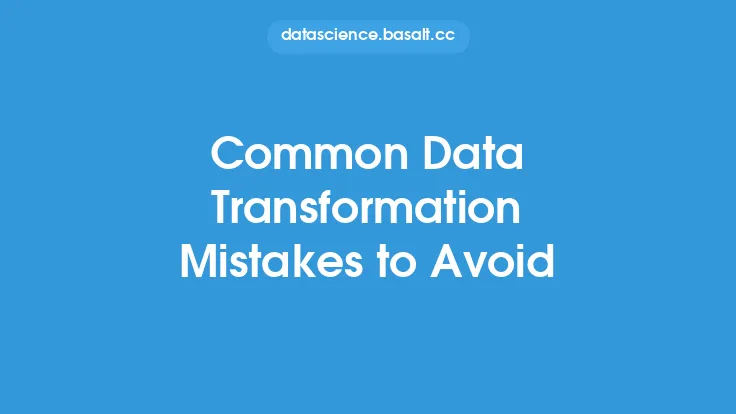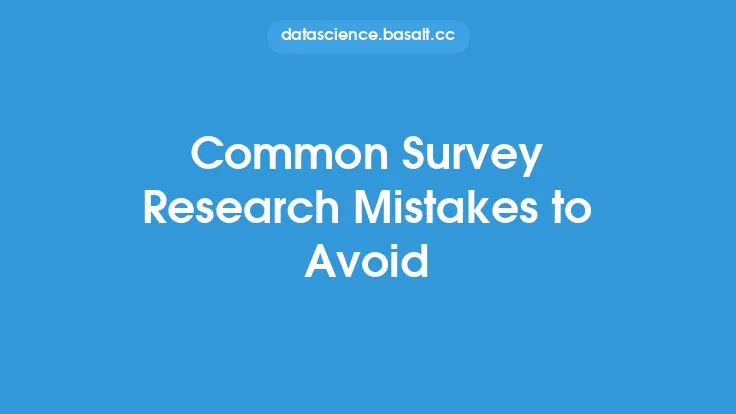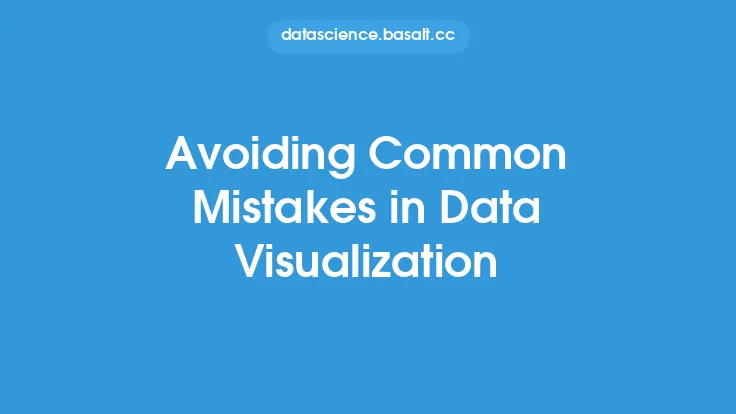Data cleaning is a crucial step in the data analysis process, as it ensures that the data is accurate, complete, and consistent. However, many data analysts and scientists make common mistakes during the data cleaning process that can have significant consequences on the accuracy and reliability of their analysis. In this article, we will discuss some of the most common data cleaning mistakes to avoid, and provide tips and best practices for ensuring that your data is clean and ready for analysis.
Introduction to Data Cleaning Mistakes
Data cleaning mistakes can occur at any stage of the data cleaning process, from data ingestion to data transformation. Some of the most common mistakes include incorrect data type conversions, inconsistent data formatting, and inadequate handling of missing or duplicate data. These mistakes can lead to biased or inaccurate analysis, and can have significant consequences in fields such as business, healthcare, and finance. To avoid these mistakes, it is essential to have a thorough understanding of the data cleaning process, and to use the right tools and techniques to ensure that the data is clean and accurate.
Inconsistent Data Formatting
Inconsistent data formatting is one of the most common data cleaning mistakes. This occurs when data is stored in different formats, such as dates, times, or currencies, and can make it difficult to compare or analyze the data. For example, if a dataset contains dates in both MM/DD/YYYY and DD/MM/YYYY formats, it can be challenging to perform date-based analysis. To avoid this mistake, it is essential to standardize data formats throughout the dataset, using techniques such as data normalization or data transformation. This can be achieved using programming languages such as Python or R, which provide a range of libraries and tools for data cleaning and formatting.
Incorrect Data Type Conversions
Incorrect data type conversions are another common data cleaning mistake. This occurs when data is converted from one data type to another, such as from a string to a numeric value, and can result in errors or inconsistencies. For example, if a dataset contains a column of numeric values stored as strings, converting this column to a numeric data type can result in errors if the strings contain non-numeric characters. To avoid this mistake, it is essential to carefully evaluate the data before converting it to a new data type, and to use techniques such as data validation or data quality checks to ensure that the data is accurate and consistent.
Overlooking Data Quality Issues
Overlooking data quality issues is a common data cleaning mistake that can have significant consequences. This occurs when data analysts or scientists fail to identify or address data quality issues, such as missing or duplicate data, and can result in biased or inaccurate analysis. To avoid this mistake, it is essential to perform thorough data quality checks, using techniques such as data profiling or data validation, to identify and address any data quality issues. This can be achieved using data quality tools or programming languages such as Python or R, which provide a range of libraries and tools for data quality checks.
Insufficient Data Documentation
Insufficient data documentation is a common data cleaning mistake that can make it challenging to understand or analyze the data. This occurs when data analysts or scientists fail to document the data cleaning process, including any transformations or conversions that were made, and can result in errors or inconsistencies. To avoid this mistake, it is essential to maintain detailed documentation of the data cleaning process, including any data quality checks or data transformations that were performed. This can be achieved using data documentation tools or programming languages such as Python or R, which provide a range of libraries and tools for data documentation.
Failure to Test and Validate
Failure to test and validate the data cleaning process is a common mistake that can have significant consequences. This occurs when data analysts or scientists fail to test or validate the data cleaning process, and can result in errors or inconsistencies. To avoid this mistake, it is essential to thoroughly test and validate the data cleaning process, using techniques such as data quality checks or data validation, to ensure that the data is accurate and consistent. This can be achieved using data quality tools or programming languages such as Python or R, which provide a range of libraries and tools for data testing and validation.
Conclusion
Data cleaning is a critical step in the data analysis process, and avoiding common data cleaning mistakes is essential for ensuring that the data is accurate, complete, and consistent. By understanding the common data cleaning mistakes, such as inconsistent data formatting, incorrect data type conversions, overlooking data quality issues, insufficient data documentation, and failure to test and validate, data analysts and scientists can take steps to avoid these mistakes and ensure that their analysis is reliable and accurate. By using the right tools and techniques, and by maintaining detailed documentation of the data cleaning process, data analysts and scientists can ensure that their data is clean and ready for analysis, and that their analysis is accurate and reliable.





